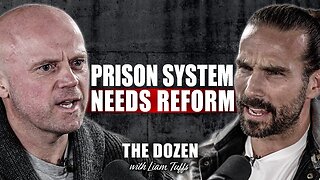Premium Only Content

US Losing Its World Status | The Gold Standard 2420
https://www.midasgoldgroup.com/
Welcome to another insightful episode of The Gold Standard with your hostess, Jennifer Horn, and guest Ken Russo, SVP of Midas Gold Group. Together they tackle a pressing issue that is shaping the global economic landscape: the United States is losing its world status. In this episode, we’ll explore the implications of this shift, the factors driving it, and what it means for the US economy and your financial future.
The Lasting Impact of the Nixon Shock of 1971
President Nixon’s decision in 1971 to sever the US dollar’s ties with gold marked a significant shift in global financial systems, setting the stage for various economic challenges we face today. Nixon intended to address immediate economic issues such as inflation and trade deficits; however, this move also introduced a new era of fiat currencies that lack intrinsic value causing increased volatility in international markets, persistent inflationary pressures, and complex fiscal policies that continue to challenge economies around the world. Domestically, it has allowed for more flexible monetary policy but at the cost of increasing national debt and diminishing financial discipline. The long-term effects of this pivotal decision are still unraveling today.
As hostess Jennifer Horn sifts through recent headlines from FOX Business News, a troubling picture of the US economy emerges. Reports like “No End in Sight for Americans: Key Inflation Report,” and “McDonald’s June $5 Meal (for a Limited Time)” underline the growing cost of living. Meanwhile, voices like Home Depot co-founder Ken Langone take the administration to task for what they see as unrealistic economic projections. Adding to the chorus, JPMorgan’s chief underscores the urgent need to address US deficits. These stories collectively paint a vivid picture of why so many are now turning to gold.
Media Echoes Economic Concerns
Ken Russo emphasizes a significant global shift: more countries are opting to conduct business outside of the US dollar, signaling a potential erosion of its status as the world reserve currency. This trend is underscored by a warning from legendary Wall Street analyst Richard X Bove, who bluntly states that the US dollar is “finished as the world’s reserve currency.” With countries like China aggressively promoting the yuan and developing a digital version to facilitate international trade, the US faces formidable competition. The growing frustration with the US using the dollar as a weapon is leading many nations to seek alternative reserve currencies.
BRICS Nations Forge a New Path
As the BRICS nations (Brazil, Russia, India, China, and South Africa) continue to strengthen their economic and political alliances, they are poised to introduce a profound shift in the global monetary system by developing their global currency.
Last year, the addition of five new members to the BRICS coalition signaled a growing frustration with the traditional dominance of the US dollar and a collective desire for greater financial independence from Western economic policies.
Proposed Global Currency
This initiative aims to reduce reliance on the dollar and foster more equitable international trade dynamics. By creating a shared currency, the BRICS countries are not just challenging the current global financial order but are also laying the groundwork for a more multipolar economic world. This could lead to significant changes in international trade practices, potentially reducing transaction costs and currency conversion complexities for member countries. As the BRICS nations push forward with this ambitious plan, the world watches closely to see how this strategy will reshape global economic interactions and power structures.
Ken Russo brings to light the alarming acceleration of the US national debt, which now stands at a staggering $34.6 trillion. Highlighting a drastic increase from the $10 trillion mark when Obama took office in 2008, Ken points out that the rampant practice of printing money to service this ever-growing debt is tearing at the financial seams of the country. This unsustainable fiscal strategy, driven by both political decisions and Federal Reserve policies, risks severe long-term consequences for economic stability and individual financial health across the nation. Using printed money to plaster over fiscal wounds undermines the value of the dollar and sets a precarious stage: future generations will bear the brunt of these policies. The discussion sheds light on the critical need for a comprehensive overhaul of how debt management and monetary policy are handled, urging a return to more sustainable and responsible fiscal practices.
______________________________________________________________________________________________
Listen to The Gold Standard: https://www.midasgoldgroup.com/gold-standard-radio-show/
Gold IRA: https://www.midasgoldgroup.com/gold-ira/
Invest in Gold: https://www.midasgoldgroup.com/buy-gold/
Guide to Owning Bullion & Coins: https://www.midasgoldgroup.com/bullion-guide/
Read the latest precious metals news: https://www.midasgoldgroup.com/news/
-
 25:04
25:04
Midas Gold Group
5 months agoA Collapse or a Reset? | The Gold Standard 2435
471 -
 2:21:11
2:21:11
Nerdrotic
9 hours ago $18.94 earnedDown the Rabbit Hole with Kurt Metzger | Forbidden Frontier #090
81.9K19 -
 2:41:13
2:41:13
vivafrei
14 hours agoEp. 251: Bogus Social Security Payments? DOGE Lawsduit W's! Maddow Defamation! & MORE! Viva & Barnes
219K252 -
 1:19:23
1:19:23
Josh Pate's College Football Show
7 hours ago $3.30 earnedBig Ten Program Rankings | What Is College Football? | Clemson Rage| Stadiums I Haven’t Experienced
54.6K1 -
 LIVE
LIVE
Vigilant News Network
12 hours agoBombshell Study Reveals Where the COVID Vaccine Deaths Are Hiding | Media Blackout
1,776 watching -
 1:17:59
1:17:59
Sarah Westall
8 hours agoDOGE: Crime & Hysteria bringing the Critics & the Fearful - Plus new CDC/Ukraine Crime w/ Dr Fleming
36.6K3 -
 45:39
45:39
Survive History
14 hours ago $6.95 earnedCould You Survive in the Shield Wall at the Battle of Hastings?
51K6 -
 1:50:28
1:50:28
TheDozenPodcast
12 hours agoViolence, Abuse, Jail, Reform: Michael Maisey
90.7K4 -
 23:01
23:01
Mrgunsngear
1 day ago $5.28 earnedWolfpack Armory AW15 MK5 AR-15 Review 🇺🇸
78.5K12 -
 25:59
25:59
TampaAerialMedia
1 day ago $3.15 earnedUpdate ANNA MARIA ISLAND 2025
49.1K4